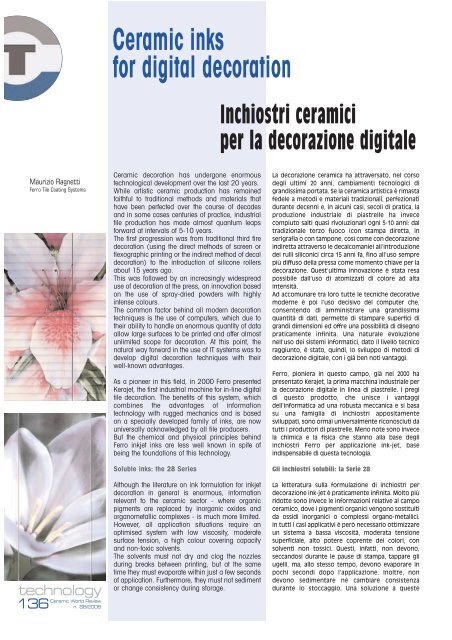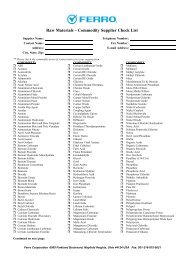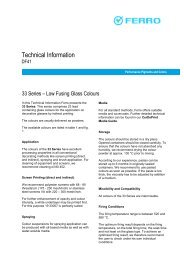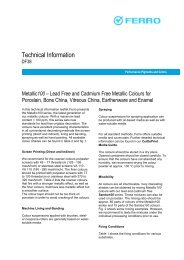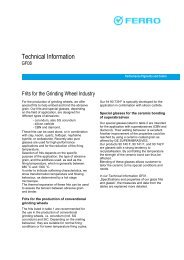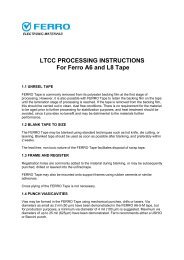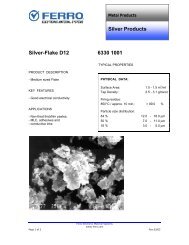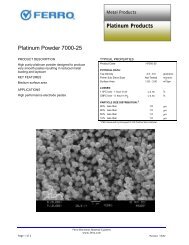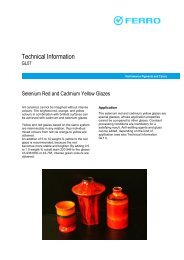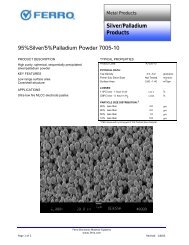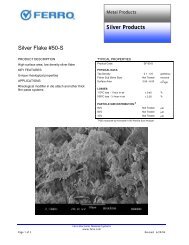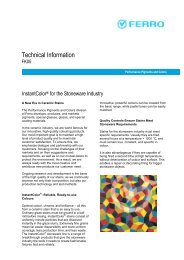Ceramic inks for digital decoration - Ferro
Ceramic inks for digital decoration - Ferro
Ceramic inks for digital decoration - Ferro
Create successful ePaper yourself
Turn your PDF publications into a flip-book with our unique Google optimized e-Paper software.
Maurizio Ragnetti<br />
<strong>Ferro</strong> Tile Coating Systems<br />
technology<br />
<strong>Ceramic</strong> World Review<br />
136 n. 68/2006<br />
<strong>Ceramic</strong> <strong>inks</strong><br />
<strong>for</strong> <strong>digital</strong> <strong>decoration</strong><br />
<strong>Ceramic</strong> <strong>decoration</strong> has undergone enormous<br />
technological development over the last 20 years.<br />
While artistic ceramic production has remained<br />
faithful to traditional methods and materials that<br />
have been perfected over the course of decades<br />
and in some cases centuries of practice, industrial<br />
tile production has made almost quantum leaps<br />
<strong>for</strong>ward at intervals of 5-10 years.<br />
The first progression was from traditional third fire<br />
<strong>decoration</strong> (using the direct methods of screen or<br />
flexographic printing or the indirect method of decal<br />
<strong>decoration</strong>) to the introduction of silicone rollers<br />
about 15 years ago.<br />
This was followed by an increasingly widespread<br />
use of <strong>decoration</strong> at the press, an innovation based<br />
on the use of spray-dried powders with highly<br />
intense colours.<br />
The common factor behind all modern <strong>decoration</strong><br />
techniques is the use of computers, which due to<br />
their ability to handle an enormous quantity of data<br />
allow large surfaces to be printed and offer almost<br />
unlimited scope <strong>for</strong> <strong>decoration</strong>. At this point, the<br />
natural way <strong>for</strong>ward in the use of IT systems was to<br />
develop <strong>digital</strong> <strong>decoration</strong> techniques with their<br />
well-known advantages.<br />
As a pioneer in this field, in 2000 <strong>Ferro</strong> presented<br />
Kerajet, the first industrial machine <strong>for</strong> in-line <strong>digital</strong><br />
tile <strong>decoration</strong>. The benefits of this system, which<br />
combines the advantages of in<strong>for</strong>mation<br />
technology with rugged mechanics and is based<br />
on a specially developed family of <strong>inks</strong>, are now<br />
universally acknowledged by all tile producers.<br />
But the chemical and physical principles behind<br />
<strong>Ferro</strong> inkjet <strong>inks</strong> are less well known in spite of<br />
being the foundations of this technology.<br />
Soluble <strong>inks</strong>: the 28 Series<br />
Although the literature on ink <strong>for</strong>mulation <strong>for</strong> inkjet<br />
<strong>decoration</strong> in general is enormous, in<strong>for</strong>mation<br />
relevant to the ceramic sector - where organic<br />
pigments are replaced by inorganic oxides and<br />
organometallic complexes - is much more limited.<br />
However, all application situations require an<br />
optimised system with low viscosity, moderate<br />
surface tension, a high colour covering capacity<br />
and non-toxic solvents.<br />
The solvents must not dry and clog the nozzles<br />
during breaks between printing, but at the same<br />
time they must evaporate within just a few seconds<br />
of application. Furthermore, they must not sediment<br />
or change consistency during storage.<br />
Inchiostri ceramici<br />
per la decorazione <strong>digital</strong>e<br />
La decorazione ceramica ha attraversato, nel corso<br />
degli ultimi 20 anni, cambiamenti tecnologici di<br />
grandissima portata. Se la ceramica artistica è rimasta<br />
fedele a metodi e materiali tradizionali, perfezionati<br />
durante decenni e, in alcuni casi, secoli di pratica, la<br />
produzione industriale di piastrelle ha invece<br />
compiuto salti quasi rivoluzionari ogni 5-10 anni: dal<br />
tradizionale terzo fuoco (con stampa diretta, in<br />
serigrafia o con tampone, così come con decorazione<br />
indiretta attraverso le decalcomanie) all’introduzione<br />
dei rulli siliconici circa 15 anni fa, fino all’uso sempre<br />
più diffuso della pressa come momento chiave per la<br />
decorazione. Quest’ultima innovazione è stata resa<br />
possibile dall’uso di atomizzati di colore ad alta<br />
intensità.<br />
Ad accomunare tra loro tutte le tecniche decorative<br />
moderne è poi l’uso decisivo del computer che,<br />
consentendo di amministrare una grandissima<br />
quantità di dati, permette di stampare superfici di<br />
grandi dimensioni ed offre una possibilità di disegno<br />
praticamente infinita. Una naturale evoluzione<br />
nell’uso dei sistemi in<strong>for</strong>matici, dato il livello tecnico<br />
raggiunto, è stato, quindi, lo sviluppo di metodi di<br />
decorazione <strong>digital</strong>e, con i già ben noti vantaggi.<br />
<strong>Ferro</strong>, pioniera in questo campo, già nel 2000 ha<br />
presentato Kerajet, la prima macchina industriale per<br />
la decorazione <strong>digital</strong>e in linea di piastrelle. I pregi<br />
di questo prodotto, che unisce i vantaggi<br />
dell’in<strong>for</strong>matica ad una robusta meccanica e si basa<br />
su una famiglia di inchiostri appositamente<br />
sviluppati, sono ormai universalmente riconosciuti da<br />
tutti i produttori di piastrelle. Meno note sono invece<br />
la chimica e la fisica che stanno alla base degli<br />
inchiostri <strong>Ferro</strong> per applicazione ink-jet, base<br />
indispensabile di questa tecnologia.<br />
Gli inchiostri solubili: la Serie 28<br />
La letteratura sulla <strong>for</strong>mulazione di inchiostri per<br />
decorazione ink-jet è praticamente infinita. Molto più<br />
ridotte sono invece le in<strong>for</strong>mazioni relative al campo<br />
ceramico, dove i pigmenti organici vengono sostituiti<br />
da ossidi inorganici o complessi organo-metallici.<br />
In tutti i casi applicativi è però necessario ottimizzare<br />
un sistema a bassa viscosità, moderata tensione<br />
superficiale, alto potere coprente dei colori, con<br />
solventi non tossici. Questi, infatti, non devono,<br />
seccandosi durante le pause di stampa, tappare gli<br />
ugelli, ma, allo stesso tempo, devono evaporare in<br />
pochi secondi dopo l’applicazione. Inoltre, non<br />
devono sedimentare né cambiare consistenza<br />
durante lo stoccaggio. Una soluzione a queste
These problems have been solved by adopting<br />
soluble heavy metal complexes, a solution that<br />
allows <strong>for</strong> the use of traditional liquid ink<br />
technology in which the required colours are<br />
developed during tile firing, i.e. when the<br />
corresponding oxides are <strong>for</strong>med.<br />
The application of inkjet ink <strong>for</strong>mulation expertise<br />
to ceramic materials has proved a major<br />
commercial success and is protected by various<br />
patents.<br />
Series 28 inkjet <strong>inks</strong> contains mixtures of solvents<br />
(mainly from the families of paraffins and glycol<br />
derivates) which due to their viscosity, boiling<br />
point and polarity have proved to be crucial <strong>for</strong> the<br />
<strong>for</strong>mation of droplets at the nozzle outlets and <strong>for</strong><br />
preventing foam <strong>for</strong>mation.<br />
The metals that create coloured compounds after<br />
combustion are well known in the ceramic sector.<br />
The Series 28 four-colour system uses cobalt <strong>for</strong><br />
light blue, chromium <strong>for</strong> yellow, ruthenium <strong>for</strong><br />
black and gold <strong>for</strong> red. After firing, gold does not<br />
produce a coloured oxide but impregnates the<br />
ceramic base with colloids with dimensions of a<br />
few nanometres, <strong>for</strong>ming the basis of the<br />
well-known “ruby red” colour.<br />
The use of dedicated stabilisers and additives in<br />
sometimes very small concentrations assures an<br />
excellent combination of the various properties<br />
listed above.<br />
Series 28 <strong>inks</strong> do not contain solids. Instead they<br />
use organometallic compounds, mostly<br />
<strong>for</strong>mulated as salts of selected fatty acids, which<br />
thanks to the choice of the most suitable<br />
components are soluble in chosen solvents and<br />
are stable in the long-term period.<br />
problematiche è stata individuata nell’impiego di<br />
complessi solubili di metalli pesanti che hanno<br />
permesso di utilizzare la tradizionale tecnologia degli<br />
inchiostri liquidi sviluppando i colori ceramici durante<br />
la cottura della piastrella quando, cioè, si <strong>for</strong>mano gli<br />
ossidi corrispondenti con i colori desiderati.<br />
L’applicazione delle conoscenze sulla <strong>for</strong>mulazione di<br />
inchiostri ink-jet a materiali ceramici è stata<br />
indubbiamente una decisione lungimirante, oggi<br />
protetta da diversi brevetti e confermata da un chiaro<br />
successo commerciale.<br />
In particolare, la Serie 28 degli inchiostri per ink-jet<br />
contiene miscele di solventi, soprattutto delle<br />
famiglie delle paraffine o dei derivati dei glicoli, che,<br />
grazie a viscosità, punto di ebollizione e polarità, si<br />
sono rivelate decisive per la <strong>for</strong>mazione delle gocce<br />
all’uscita dagli ugelli e per prevenire la <strong>for</strong>mazione di<br />
schiuma. I metalli che, dopo la combustione, daranno<br />
origine ai composti colorati, sono ben conosciuti in<br />
ceramica. Il sistema quadricromatico della Serie 28 usa<br />
infatti cobalto per l’azzurro, cromo per il giallo,<br />
rutenio per il nero e oro per il rosso.<br />
Quest’ultimo, dopo la cottura, non produce un ossido<br />
colorato, ma impregna la base ceramica di colloidi con<br />
dimensioni di pochi nanometri: la base del ben<br />
conosciuto “rosso rubino”. L’uso di stabilizzatori ed<br />
additivi appositi, in concentrazioni a volte minime,<br />
porta ad un’ottima combinazione delle diverse<br />
proprietà elencate.<br />
Gli inchiostri della Serie 28, non contengono solidi.<br />
Si utilizzano quindi composti organo-metallici,<br />
<strong>for</strong>mulati per la maggior parte come sali di acidi grassi<br />
selezionati e, grazie alla scelta dei componenti più<br />
adatti, solubili nei solventi scelti e stabili nell’arco di<br />
lungo tempo.<br />
28 Series - Serie 28<br />
This page - in questa pagina<br />
- 'Pensieri' (above/in alto):<br />
Through-bodied porcelain tile.<br />
Ink-jet printing on relief-body<br />
!res porcellanato tecnico. /ta0pa<br />
ink-3et su i0pasto cera0ico strutturato.<br />
- 'Sassi' (below/in basso):<br />
Ink-jet <strong>decoration</strong> on glazed porcelain<br />
tile, relief-body<br />
Decora6ione ink-3et su i0pasto<br />
cera0ico strutturato e s0altato<br />
Facing page - nella pagina a fianco<br />
(above/in alto) Double fast firing wall tile<br />
panel decorated through ink-jet system on<br />
striped relief-body. Manufactured (and<br />
reproducted with the kind permission of)<br />
by Tandem (Rubiera, Italy)<br />
Pannello di rivesti0ento con decora6ione<br />
ink-3et su supporto strutturato a righe.<br />
da<br />
Tande0 =<br />
(below/in basso) Double fast firing wall tile<br />
panel decorated through ink-jet system.<br />
Manufactured by Tandem (Rubiera, Italy)<br />
Pannello di rivesti0ento con decora6ione<br />
ink-3et.
48 Series - !erie &'<br />
- ‘Vyara’ (above/foto in alto):<br />
inkjet <strong>decoration</strong> on monoporosa tile<br />
decora6ione ink-3et su 0onoporosa<br />
- ‘Roseton’ (below/foto in basso):<br />
inkjet <strong>decoration</strong> on glazed porcelain tile<br />
decora6ione ink-3et su gres<br />
porcellanato s0altato<br />
technology<br />
<strong>Ceramic</strong> World Review<br />
138 n. 68/2006<br />
The advantages of liquid <strong>inks</strong> include:<br />
- stability during storage<br />
- no risk of clogging nozzles<br />
- relative ease of cleaning printing machines<br />
- uni<strong>for</strong>m dispersion of droplets on the tiles<br />
as they penetrate inside the ceramic body<br />
- the possibility of superimposing colours with<br />
a high degree of transparency so that the<br />
colours on top do not hide the colours<br />
underneath, thereby producing attractive<br />
heterogeneous shade effects.<br />
Series 28 also has other advantages, including<br />
a good colour palette with bright colours<br />
developed using glazes that are particularly<br />
suitable <strong>for</strong> fast firing at temperatures of between<br />
1000°C and 1150°C. The most important<br />
advantage however is obtained if Series 28 is<br />
used <strong>for</strong> decorating unglazed ceramic body such<br />
as through-bodied porcelain tile. In this case the<br />
<strong>inks</strong> penetrate inside the body and create a<br />
palette characterised by warm colours that are<br />
particularly suitable <strong>for</strong> imitating the most widely<br />
used natural stones.<br />
The technological challenge of Series 48<br />
pigmented <strong>inks</strong><br />
The decorative scope of the inkjet system can be<br />
extended using <strong>inks</strong> based on an enormous<br />
palette of ceramic pigments, although they have<br />
entirely different chemical and physical<br />
characteristics. The solid-liquid interactions must<br />
there<strong>for</strong>e be studied and controlled using<br />
additives of a different nature. With pigmented<br />
colours, the issue of stability becomes crucial.<br />
Instead of a liquid solution, the <strong>inks</strong> consist of a<br />
dispersion of granules with a density 3-4 times<br />
higher than that of the solvent, which there<strong>for</strong>e<br />
tends to sediment during storage and in all parts<br />
of the machine where mechanical stirring is not<br />
per<strong>for</strong>med. The abrasive properties of pigments<br />
are no less important due to the risk of<br />
irremediably damaging the nozzles. The solution<br />
developed by <strong>Ferro</strong>, called Series 48, is based<br />
on dispersions of pigments with diameters of just<br />
a few hundred nanometres, stabilised by special<br />
additives capable of covering the surfaces of<br />
pigments and controlling their wettability.<br />
A critical choice was that of the solvent, which<br />
sometimes has to be adapted to the chosen<br />
pigment by the use of an additive. The best<br />
properties, especially in terms of safety in the<br />
workplace, are obtained with polar solvents such<br />
as ethers or glycol esters.<br />
Series 48 pigmented <strong>inks</strong> have properties that are<br />
different from but complementary to those of Series 28:<br />
I vantaggi degli inchiostri liquidi sono evidenti:<br />
- stabilità allo stoccaggio;<br />
- nessun pericolo che si tappino gli ugelli;<br />
- pulizia relativamente facile delle macchine<br />
da stampa;<br />
- dispersione omogenea della goccia sulla<br />
piastrella, che penetra nella massa ceramica;<br />
- possibilità di sovrapporre colori quasi in<br />
trasparenza, senza che il colore superiore<br />
copra l’inferiore ed ottenendo quindi piacevoli<br />
tonalità sfumate.<br />
La Serie 28 presenta altri vantaggi: una buona paletta<br />
cromatica dai colori vivaci, che si sviluppano con<br />
smalti particolarmente idonei alle cotture rapide<br />
comprese tra i 1000 e 1150 °C. Il vantaggio più<br />
significativo si ha però se la Serie 28 viene utilizzata<br />
per la decorazione di impasti ceramici non smaltati<br />
(come nel gres porcellanato tecnico). In questo caso<br />
gli inchiostri penetrano nell’impasto e permettono<br />
lo sviluppo di una paletta caratterizzata da tinte<br />
calde, particolarmente idonea quindi alla<br />
simulazione grafica delle pietre più comuni.<br />
La sfida tecnologica degli inchiostri pigmentati<br />
Serie 48<br />
Un ampliamento delle possibilità decorative del<br />
sistema ink-jet è possibile usando inchiostri basati<br />
sulla vasta paletta dei pigmenti ceramici,<br />
caratterizzati però da una chimica e una fisica<br />
totalmente diverse.<br />
Le interazioni solido-liquido vanno quindi studiate e<br />
regolate grazie ad additivi di natura differente. Con<br />
le tinte pigmentate, il tema della stabilità si fa<br />
cruciale: non più una soluzione liquida, ma una<br />
dispersione di granuli con densità 3-4 volte<br />
superiore a quella del solvente, che ha quindi la<br />
tendenza a sedimentare durante lo stoccaggio ed<br />
in tutte le parti della macchina dove manchi<br />
un’agitazione meccanica. Da non trascurare, le<br />
proprietà abrasive dei pigmenti che rischiano di<br />
danneggiare irrimediabilmente gli ugelli.<br />
La soluzione sviluppata da <strong>Ferro</strong>, denominata Serie<br />
48, si basa su dispersioni di pigmenti con dimensioni<br />
di poche centinaia di nanometri, stabilizzati da<br />
additivi particolari in grado di ricoprire la superficie<br />
dei pigmenti e regolarne la bagnabilità. Decisiva è la<br />
scelta del solvente che, a volte, deve essere<br />
adattato con l’additivo al pigmento prescelto. Le<br />
migliori proprietà, anche pensando alla sicurezza<br />
sul lavoro, sono offerte da solventi polari come gli<br />
eteri o esteri glicolici.<br />
La Serie 48 di inchiostri pigmentati è dotata di proprietà<br />
diverse e complementari a quelle della Serie 28:<br />
- alta definizione dell’immagine, poiché il pigmento
- high image definition because the pigment does<br />
not penetrate inside the tile surface<br />
- colour production that is generally independent<br />
of the glaze used<br />
- greater colour intensity at low and high<br />
temperatures with the possibility of creating<br />
a wide variety of <strong>decoration</strong>s.<br />
As will be evident from the above considerations,<br />
the applications of <strong>digital</strong> <strong>decoration</strong> are virtually<br />
unlimited, but in order to be able to exploit them<br />
effectively it is essential to correctly understand<br />
the chemical and physical processes involved.<br />
With the Series 28 and 48, <strong>Ferro</strong> has established<br />
a leading position in the field and is working<br />
hard to further improve and extend its range<br />
of <strong>inks</strong>.<br />
<strong>Ferro</strong>’s research laboratories are working<br />
towards the objectives of further improving<br />
colour intensity, creating a colour range as close<br />
as possible to theoretical potential, extending the<br />
existing standard system from four to seven<br />
colours and optimising special colours.<br />
non penetra all’interno della superficie della<br />
piastrella;<br />
- sviluppo del colore indipendente, in generale,<br />
dallo smalto utilizzato;<br />
- maggiore intensità cromatica a basse e alte<br />
temperature con possibilità di realizzare<br />
una più ampia varietà di disegni.<br />
Come è desumibile da quanto detto finora, le<br />
applicazioni della decorazione <strong>digital</strong>e sono<br />
praticamente infinite, ma la loro realizzazione è<br />
possibile solo grazie alla comprensione di complessi<br />
processi chimico-fisici. Con le Serie 28 e 48 <strong>Ferro</strong> si è<br />
posta all’avanguardia in questo campo, e sta<br />
attivamente lavorando al perfezionamento ed<br />
amplia-mento delle gamme di inchiostri disponibili.<br />
Un aumento dell’intensità del colore, lo sviluppo di<br />
una gamma cromatica il più vicino possibile alle<br />
possibilità teoriche, l’ampliamento del sistema base<br />
da quattro a sette colori, così come l’ottimizzazione<br />
di tonalità particolari sono gli obiettivi ai quali <strong>Ferro</strong><br />
sta intensamente lavorando nei suoi laboratori<br />
di ricerca.


